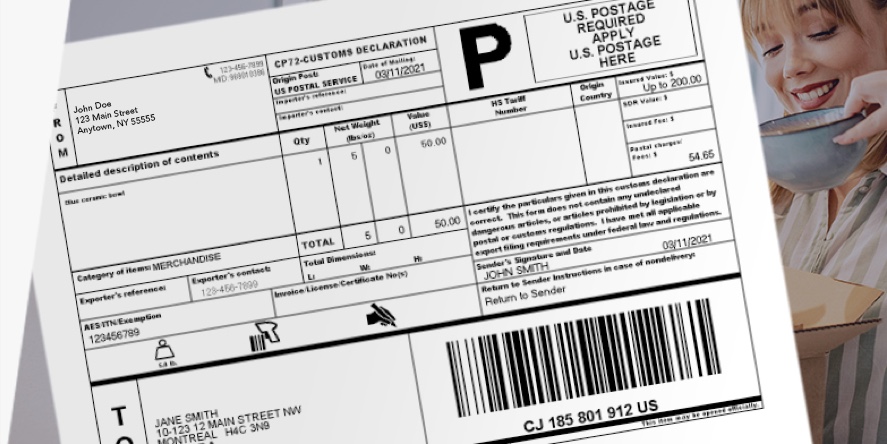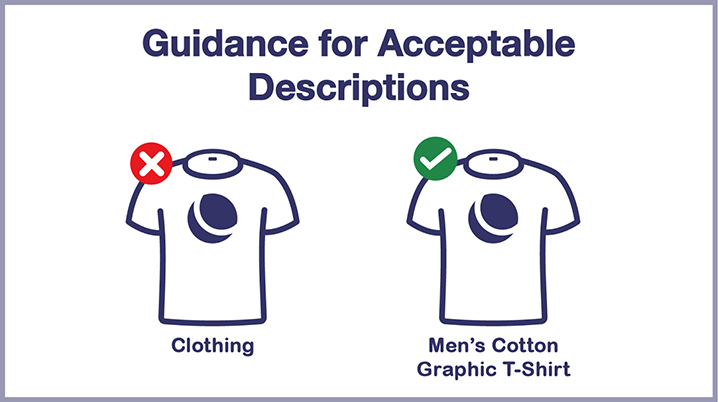
Customs Forms
Filling Out Customs Forms Online
When you ship items from the U.S. to another country, you must fill out customs forms (except for First-Class Mail International® letters and large envelopes under 15.994 oz):
- The form you need depends on the USPS® mail service you use (and the total value of what you send).
- You can print just a customs form and save time at the Post Office™ with Customs Form Online, or use Click-N-Ship® service to pay for postage and print an international shipping label and customs form.
Create Customs Form Now
Click-N-Ship: Print Shipping Label & Customs Form

Customs forms for all packages sent internationally now require more detailed item descriptions. Learn what you need to do.
New Requirement: Detailed Content Descriptions for All International Packages
If you're sending packages from the U.S. to any other country, you must now put more detailed item descriptions on your customs forms.
If you don't follow customs forms requirements, the customs officials in the receiving country may reject, return, or potentially even destroy your package.
Note: If you're mailing First-Class Mail International® service envelopes containing only documents that don't require customs forms, these new rules don't apply to you.

These rules apply to all international packages, here's what you need to know:
- All outbound international packages, including small personal gifts, ecommerce orders, and military and diplomatic mail (APO/DPO/FPO) must follow these rules.
- Every item in your package needs an appropriately detailed description on the customs form.
- Each description must be specific: Detailed descriptions should make it clear what the item is, what it's made of, and what its purpose is. For example, instead of a general category like "electronics," you must be specific about the type of electronics, like "laptop computer," "mobile phone," or "television."
Guidance for Acceptable Descriptions
| Unacceptable | Acceptable |
|---|---|
| Clothes | Men's cotton shirts, girls' denim vest, artificial fur coat |
| Appliances | 18 cubic feet refrigerator and freezer, microwave oven |
| Artwork | Original oil painting, pencil sketch, bronze statue |
| Battery | Lithium batteries |
| Gifts | One scented candle, remote-controlled toy car, cashmere scarf |
| Medicine | Painkillers (ibuprofen), antiviral spray medication |
| Health & Beauty Products | Laundry detergent, toothbrush, cotton towels |
| Vegetables | Fresh eggplant, sun-dried tomatoes, frozen broccoli |
| Nuts | Container of mixed nuts |
| Tools | Screwdriver, power drill, rubber mallet |
USPS tools may also ask for other types of information (like the Universal Product Code, known as "UPC code," the brand name, etc.) to help identify the right Harmonized System (HS) code for an item.
Customers do not need to look up these numerical codes themselves; if you use USPS tools (like Click-N-Ship, Customs Forms Online, the International Retail Postage Price Calculator, or Global Shipping Software) and give acceptable descriptions, USPS will be able to assign the correct HS Codes on your customs declaration form.
Why do item descriptions need more detail?
Customs authorities worldwide require HS Codes to screen incoming goods. By writing an acceptable item description on your customs form, you help to:
- Streamline customs processing
- Prevent delays
- Improve the efficiency of cross-border ecommerce
- Meet safety and security requirements
Harmonized System Tariff Codes are very complex. You can learn more about HS Tariff Codes here. (You can also Look Up HS Codes yourself.)
What to Include on Your Customs Form
Sender Information
Do not use any abbreviations.
- Name: Complete First Name and Last Name
- Address: Road Name, Number, ZIP Code™, City, State
- Contact Information: Phone, Email
Recipient Information
Do not use any abbreviations.
- Name: Complete First Name and Last Name
- Address: Road Name, Number, ZIP Code™, City, State
- Contact Information: Phone, Email
Item Value
You must include a separate and specific value for all items in your shipment. Once calculated, include a total value for the shipment.
Item Description
When you ship internationally, every item in your package must now have a detailed, clear, and specific description on the customs form that makes it clear:
- What the item is
- What it's made of
- What its purpose is
Instead of naming a general category, your description must be specific. For example: Instead of "tools," you must specify the type of tools, like "a screwdriver" or "power drill."
For additional information, view the Detailed Content Descriptions for All International Packages section above.
Packet or Package Weight
You must include the total gross weight of the package and the unit of calculation (i.e., pounds or kilograms).
HS Tariff Code
As described above, Harmonized System (HS) Tariff Codes are 6-to-10-digit identifiers linked to specific goods descriptions. Customs authorities worldwide use them to ensure safety, security, and efficiency in the international shipping process.
As a customer, you are responsible for accurately describing the item you are shipping, and USPS will provide an HS Code for your customs form during processing. (If you prefer, you can also Look Up HS Codes yourself.)
While your role as a customer is simple, Harmonized System Codes can be complex. You can learn more about HS codes here or by reading the details below.
What is the Harmonized System?
The Harmonized Commodity Description and Coding System, generally referred to as "Harmonized System" or "HS," is a multipurpose international product nomenclature developed by the World Customs Organization (WCO). The system categorizes commodity groups by six-digit codes, creating a universal economic language for the shipping of goods. These codes are used for internal taxes, trade policies, monitoring of controlled goods, rules of origin, freight tariffs, transport statistics, price monitoring, quota controls, compilation of national accounts, and economic research and analysis. The WCO updates the HS every 5 years.1
Countries often add additional digits to the end of the six-digit code to further classify products. The United States uses a 10-digit code to classify products.2
For example, a generic description like "tools" is not enough to narrow down an HS code. However, "power drill" is enough to identify a specific HS code (8467.21).
What are the Challenges?3
- The Harmonized System is complex; it is difficult and expensive to implement and requires extensive training.
- Countries create unique sub-classifications that do not align internationally.
- The WCO recommends quantities associated with the HS codes which do not always align with the quantities used in industry practices that vary across countries.
- Frequent revisions of the HS result in the discontinuation or merging of some codes every five years, causing issues in analysis and implementation across countries.
It is recognized that many of the challenges faced by the HS are inherent and unavoidable in any multipurpose international commodity classification.
More About Customs Forms
Do all shipments need a customs form?
You do not need a customs form if you're sending First-Class Mail International® that weighs under 15.994 oz.
First-Class Mail International must contain only nonnegotiable documents or correspondence.
Everything else that you send to another country (including US embassies or US military bases abroad) must have a customs form.
Can I complete a customs form at the Post Office?
If you didn't complete your customs form online or are using postage stamps on a package that requires a customs form, visit your local Post Office™ branch, fill out form PS 2976-R, and present your package at the counter to have the clerk create your label.
How can I print a shipping label and customs form?
Click-N-Ship will print a customs form for you if you use any of the services listed below and print international postage.
- First-Class Package International Service®
- Priority Mail Express International®
- Priority Mail International®
After you prepare your package, you can schedule a free Package Pickup or take your package to your local Post Office location.
Which form do I need to fill out?
For Priority Mail Express International® and all other USPS international services, including APO/FPO/DPO mail, use PS Form 2976-R, and take your package to the counter for the clerk to create the label.
Do I need a customs form for packages going to an APO/FPO/DPO?
In most cases, you'll need a customs form when you send shipments to overseas military bases and embassies.
Where do I find the country-specific requirements?
Each country has specific customs requirements, which you can find in our Individual Country Listings.
Where do I find additional information about customs forms?
Check these resources for more information about required customs forms.
What has changed?
Because of technology and security challenges, other countries now require more detail about what's inside incoming international packages. Product descriptions for every item in your packages must be detailed, clear, and specific.
Why do I need to follow these Customs rules?
When you follow customs rules by providing detailed description and giving all the required information, it will streamline your package's journey. If you don't fill out the forms properly, the receiving country may return, discard, or destroy your package.



